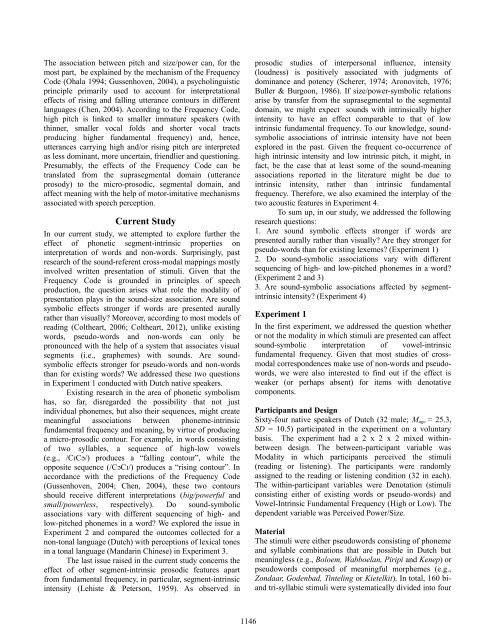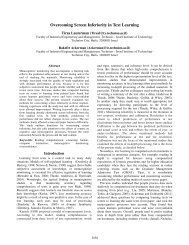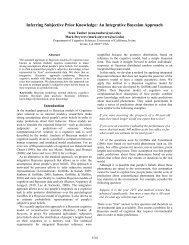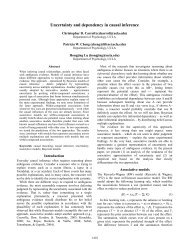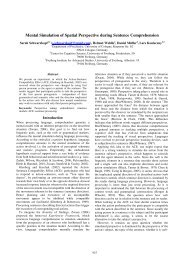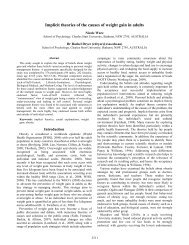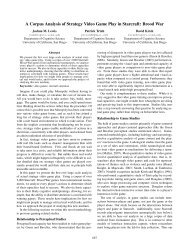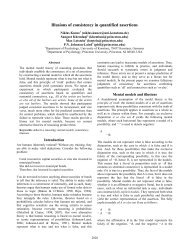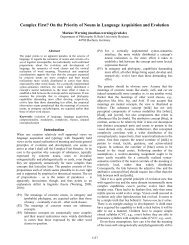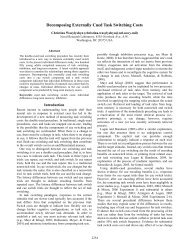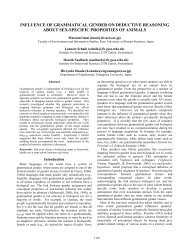Systematic Sound-Meaning Associations in Novel and Existing Words
Systematic Sound-Meaning Associations in Novel and Existing Words
Systematic Sound-Meaning Associations in Novel and Existing Words
You also want an ePaper? Increase the reach of your titles
YUMPU automatically turns print PDFs into web optimized ePapers that Google loves.
The association between pitch <strong>and</strong> size/power can, for the<br />
most part, be expla<strong>in</strong>ed by the mechanism of the Frequency<br />
Code (Ohala 1994; Gussenhoven, 2004), a psychol<strong>in</strong>guistic<br />
pr<strong>in</strong>ciple primarily used to account for <strong>in</strong>terpretational<br />
effects of ris<strong>in</strong>g <strong>and</strong> fall<strong>in</strong>g utterance contours <strong>in</strong> different<br />
languages (Chen, 2004). Accord<strong>in</strong>g to the Frequency Code,<br />
high pitch is l<strong>in</strong>ked to smaller immature speakers (with<br />
th<strong>in</strong>ner, smaller vocal folds <strong>and</strong> shorter vocal tracts<br />
produc<strong>in</strong>g higher fundamental frequency) <strong>and</strong>, hence,<br />
utterances carry<strong>in</strong>g high <strong>and</strong>/or ris<strong>in</strong>g pitch are <strong>in</strong>terpreted<br />
as less dom<strong>in</strong>ant, more uncerta<strong>in</strong>, friendlier <strong>and</strong> question<strong>in</strong>g.<br />
Presumably, the effects of the Frequency Code can be<br />
translated from the suprasegmental doma<strong>in</strong> (utterance<br />
prosody) to the micro-prosodic, segmental doma<strong>in</strong>, <strong>and</strong><br />
affect mean<strong>in</strong>g with the help of motor-imitative mechanisms<br />
associated with speech perception.<br />
Current Study<br />
In our current study, we attempted to explore further the<br />
effect of phonetic segment-<strong>in</strong>tr<strong>in</strong>sic properties on<br />
<strong>in</strong>terpretation of words <strong>and</strong> non-words. Surpris<strong>in</strong>gly, past<br />
research of the sound-referent cross-modal mapp<strong>in</strong>gs mostly<br />
<strong>in</strong>volved written presentation of stimuli. Given that the<br />
Frequency Code is grounded <strong>in</strong> pr<strong>in</strong>ciples of speech<br />
production, the question arises what role the modality of<br />
presentation plays <strong>in</strong> the sound-size association. Are sound<br />
symbolic effects stronger if words are presented aurally<br />
rather than visually? Moreover, accord<strong>in</strong>g to most models of<br />
read<strong>in</strong>g (Coltheart, 2006; Coltheart, 2012), unlike exist<strong>in</strong>g<br />
words, pseudo-words <strong>and</strong> non-words can only be<br />
pronounced with the help of a system that associates visual<br />
segments (i.e., graphemes) with sounds. Are soundsymbolic<br />
effects stronger for pseudo-words <strong>and</strong> non-words<br />
than for exist<strong>in</strong>g words? We addressed these two questions<br />
<strong>in</strong> Experiment 1 conducted with Dutch native speakers.<br />
Exist<strong>in</strong>g research <strong>in</strong> the area of phonetic symbolism<br />
has, so far, disregarded the possibility that not just<br />
<strong>in</strong>dividual phonemes, but also their sequences, might create<br />
mean<strong>in</strong>gful associations between phoneme-<strong>in</strong>tr<strong>in</strong>sic<br />
fundamental frequency <strong>and</strong> mean<strong>in</strong>g, by virtue of produc<strong>in</strong>g<br />
a micro-prosodic contour. For example, <strong>in</strong> words consist<strong>in</strong>g<br />
of two syllables, a sequence of high-low vowels<br />
(e.g., /CɪCɔ/) produces a “fall<strong>in</strong>g contour”, while the<br />
opposite sequence (/CɔCɪ/) produces a “ris<strong>in</strong>g contour”. In<br />
accordance with the predictions of the Frequency Code<br />
(Gussenhoven, 2004; Chen, 2004), these two contours<br />
should receive different <strong>in</strong>terpretations (big/powerful <strong>and</strong><br />
small/powerless, respectively). Do sound-symbolic<br />
associations vary with different sequenc<strong>in</strong>g of high- <strong>and</strong><br />
low-pitched phonemes <strong>in</strong> a word? We explored the issue <strong>in</strong><br />
Experiment 2 <strong>and</strong> compared the outcomes collected for a<br />
non-tonal language (Dutch) with perceptions of lexical tones<br />
<strong>in</strong> a tonal language (M<strong>and</strong>ar<strong>in</strong> Ch<strong>in</strong>ese) <strong>in</strong> Experiment 3.<br />
The last issue raised <strong>in</strong> the current study concerns the<br />
effect of other segment-<strong>in</strong>tr<strong>in</strong>sic prosodic features apart<br />
from fundamental frequency, <strong>in</strong> particular, segment-<strong>in</strong>tr<strong>in</strong>sic<br />
<strong>in</strong>tensity (Lehiste & Peterson, 1959). As observed <strong>in</strong><br />
1146<br />
prosodic studies of <strong>in</strong>terpersonal <strong>in</strong>fluence, <strong>in</strong>tensity<br />
(loudness) is positively associated with judgments of<br />
dom<strong>in</strong>ance <strong>and</strong> potency (Scherer, 1974; Aronovitch, 1976;<br />
Buller & Burgoon, 1986). If size/power-symbolic relations<br />
arise by transfer from the suprasegmental to the segmental<br />
doma<strong>in</strong>, we might expect sounds with <strong>in</strong>tr<strong>in</strong>sically higher<br />
<strong>in</strong>tensity to have an effect comparable to that of low<br />
<strong>in</strong>tr<strong>in</strong>sic fundamental frequency. To our knowledge, soundsymbolic<br />
associations of <strong>in</strong>tr<strong>in</strong>sic <strong>in</strong>tensity have not been<br />
explored <strong>in</strong> the past. Given the frequent co-occurrence of<br />
high <strong>in</strong>tr<strong>in</strong>sic <strong>in</strong>tensity <strong>and</strong> low <strong>in</strong>tr<strong>in</strong>sic pitch, it might, <strong>in</strong><br />
fact, be the case that at least some of the sound-mean<strong>in</strong>g<br />
associations reported <strong>in</strong> the literature might be due to<br />
<strong>in</strong>tr<strong>in</strong>sic <strong>in</strong>tensity, rather than <strong>in</strong>tr<strong>in</strong>sic fundamental<br />
frequency. Therefore, we also exam<strong>in</strong>ed the <strong>in</strong>terplay of the<br />
two acoustic features <strong>in</strong> Experiment 4.<br />
To sum up, <strong>in</strong> our study, we addressed the follow<strong>in</strong>g<br />
research questions:<br />
1. Are sound symbolic effects stronger if words are<br />
presented aurally rather than visually? Are they stronger for<br />
pseudo-words than for exist<strong>in</strong>g lexemes? (Experiment 1)<br />
2. Do sound-symbolic associations vary with different<br />
sequenc<strong>in</strong>g of high- <strong>and</strong> low-pitched phonemes <strong>in</strong> a word?<br />
(Experiment 2 <strong>and</strong> 3)<br />
3. Are sound-symbolic associations affected by segment<strong>in</strong>tr<strong>in</strong>sic<br />
<strong>in</strong>tensity? (Experiment 4)<br />
Experiment 1<br />
In the first experiment, we addressed the question whether<br />
or not the modality <strong>in</strong> which stimuli are presented can affect<br />
sound-symbolic <strong>in</strong>terpretation of vowel-<strong>in</strong>tr<strong>in</strong>sic<br />
fundamental frequency. Given that most studies of crossmodal<br />
correspondences make use of non-words <strong>and</strong> pseudowords,<br />
we were also <strong>in</strong>terested to f<strong>in</strong>d out if the effect is<br />
weaker (or perhaps absent) for items with denotative<br />
components.<br />
Participants <strong>and</strong> Design<br />
Sixty-four native speakers of Dutch (32 male; Mage = 25.3,<br />
SD = 10.5) participated <strong>in</strong> the experiment on a voluntary<br />
basis. The experiment had a 2 x 2 x 2 mixed with<strong>in</strong>between<br />
design. The between-participant variable was<br />
Modality <strong>in</strong> which participants perceived the stimuli<br />
(read<strong>in</strong>g or listen<strong>in</strong>g). The participants were r<strong>and</strong>omly<br />
assigned to the read<strong>in</strong>g or listen<strong>in</strong>g condition (32 <strong>in</strong> each).<br />
The with<strong>in</strong>-participant variables were Denotation (stimuli<br />
consist<strong>in</strong>g either of exist<strong>in</strong>g words or pseudo-words) <strong>and</strong><br />
Vowel-Intr<strong>in</strong>sic Fundamental Frequency (High or Low). The<br />
dependent variable was Perceived Power/Size.<br />
Material<br />
The stimuli were either pseudowords consist<strong>in</strong>g of phoneme<br />
<strong>and</strong> syllable comb<strong>in</strong>ations that are possible <strong>in</strong> Dutch but<br />
mean<strong>in</strong>gless (e.g., Boloem, Wabboelan, Piripi <strong>and</strong> Kenep) or<br />
pseudowords composed of mean<strong>in</strong>gful morphemes (e.g.,<br />
Zondaar, Godenbad, T<strong>in</strong>tel<strong>in</strong>g or Kietelkit). In total, 160 bi-<br />
<strong>and</strong> tri-syllabic stimuli were systematically divided <strong>in</strong>to four


